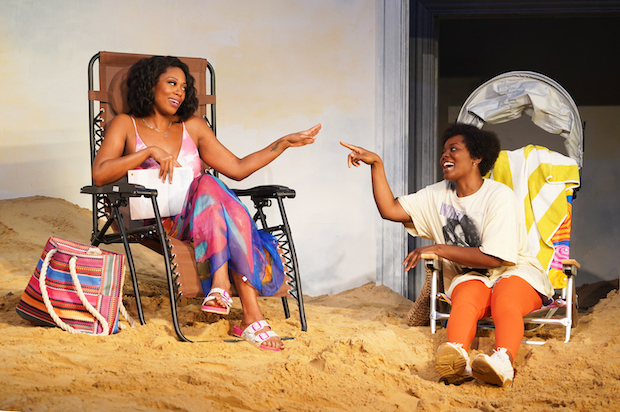Review: Things Literally Fall Apart for Black Women in Sandblasted
Charly Evon Simpson’s play runs at the Vineyard Theatre.

(© Carol Rosegg)
Black women are expected to be strong, to keep it together, despite the fact that they constantly face intersectional forms of oppression that ceaselessly wear them down. Charly Evon Simpson's sandblasted (styled with a lowercase s), a Vineyard Theatre and WP Theater production directed by Summer L. Williams, explores this struggle with a bit of a speculative twist: What would happen if Black women, in response to the neverending sexism and racism they face on a daily basis and all that the world demands of them, literally began to fall apart?
Sandblasted uses this as its central premise, telling the story of the anxious Angela (Brittany Bellizeare) and the laissez-faire Odessa (Marinda Anderson) as they wander a desert, searching for answers both in a philosophical and spiritual sense, but also in a tangible and embodied sense in the form of Adah (Rolonda Watts), a health guru, author, and motivational speaker — some mashup of Oprah and Gwenyth Paltrow. In a world where Black women have begun to literally fall apart (with ears, arms, toes, and more all suddenly dropping off the body), Adah is aging gracefully, staying intact, and claiming to have some answers.

(© Carol Rosegg)
When Angela and Odessa wander the sands and find Adah, however, they learn that those answers are not so clear, and are certainly not as easy as a lotion or a potion. Much of the play is spent wandering, searching for Adah, for answers, for a cure — or in the case of Angela, for a fulgurite, a delicate glass tube resembling a tree root that forms when lightning hits sand in just the right way. The rare but beautiful object acts as a compelling symbol for the women of the play, who are beautiful and special, who are fragile, and who should be treasured.
About a third of the way through the play (which is not told in a strictly chronological order), Adah gives a motivational speech, telling us that she used to give talks on how to live when your life is crumbling, but now gives talks to Black women on how to live when your body is actually falling apart; she aptly says "one was a metaphor and one was magical realism, or maybe it was just realism, just this is how it is right now-ism, this is how it feels-ism." Just as the fulgurite is Simpson's main symbol for the play, Adah's line feels like its genre statement, telling us how the play works.
In addition to wandering, one of the key themes here is waiting. While Adah's mantra is "waiting is suffering" — and thus we need to focus on living — by the end of the play, and after a great deal of waiting and searching, Odessa realizes that "there is waiting to do, to see if there is a way to heal, to see how we survive" and that therefore waiting need not be suffering. Angela herself concludes that "waiting can just be us, living."

(© Carol Rosegg)
In this, the play builds on Samuel Beckett's Waiting for Godot (and perhaps even Antoinette Chinonye Nwandu's Pass Over), finding a more compelling, less nihilistic, set of answers. At times the philosophical nature of the play can zoom out a bit and become somewhat generalized. But this broader conversation about waiting, living, surviving, and radical self-care — coming from three Black women who are tired, struggling, and falling apart — still comes across as deeply specific and embodied.
The play's one major weakness is its length: the play runs an hour and 40 minutes and could certainly be trimmed. Some of the scenes feel repetitive, or do not necessarily advance the play. The presence of a lone male character, Jamal (Andy Lucien), Angela's brother and a bartender who flirts with Odessa, felt particularly superfluous and out of place. For a play about searching for answers in the sand, I wish that sandblasted dug a little deeper, developed its themes more, and made better use of its run time. This is a great idea for a play, but the final product does not seem as good as it could be.
While the text has some weaknesses, all the other aspects of the play are top-notch. The design, a sand-flooded room with puff clouds by Matt Saunders and gorgeous ethereal lighting by Stacey Derosier, is absolutely perfect. The performances by the women are superlative across the board: Bellizeare's worried intensity, Anderson's singsong confidence, and Watts's basking in the glory of sunshine-and-sequins wisdom carry the show. Combined, the design and acting cover up any textual imperfections, creating an enjoyable experience that will linger with you after the play ends, leaving you with a lot to think about — and maybe even some soul-searching of your own to do.









